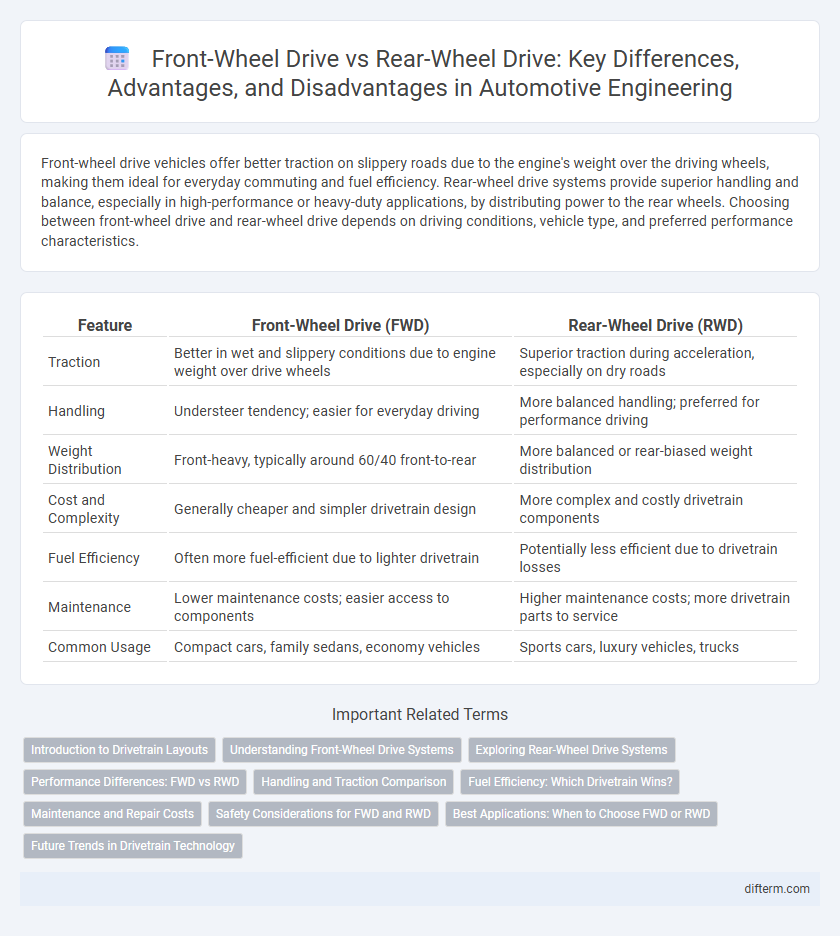Front-wheel drive vehicles offer better traction on slippery roads due to the engine's weight over the driving wheels, making them ideal for everyday commuting and fuel efficiency. Rear-wheel drive systems provide superior handling and balance, especially in high-performance or heavy-duty applications, by distributing power to the rear wheels. Choosing between front-wheel drive and rear-wheel drive depends on driving conditions, vehicle type, and preferred performance characteristics.
Table of Comparison
| Feature | Front-Wheel Drive (FWD) | Rear-Wheel Drive (RWD) |
|---|---|---|
| Traction | Better in wet and slippery conditions due to engine weight over drive wheels | Superior traction during acceleration, especially on dry roads |
| Handling | Understeer tendency; easier for everyday driving | More balanced handling; preferred for performance driving |
| Weight Distribution | Front-heavy, typically around 60/40 front-to-rear | More balanced or rear-biased weight distribution |
| Cost and Complexity | Generally cheaper and simpler drivetrain design | More complex and costly drivetrain components |
| Fuel Efficiency | Often more fuel-efficient due to lighter drivetrain | Potentially less efficient due to drivetrain losses |
| Maintenance | Lower maintenance costs; easier access to components | Higher maintenance costs; more drivetrain parts to service |
| Common Usage | Compact cars, family sedans, economy vehicles | Sports cars, luxury vehicles, trucks |
Introduction to Drivetrain Layouts
Front-wheel drive (FWD) systems deliver power from the engine to the front wheels, enhancing fuel efficiency and providing better traction on slippery surfaces due to the weight of the engine over the driven wheels. Rear-wheel drive (RWD) layouts send power to the rear wheels, offering improved handling and acceleration dynamics favored in performance and luxury vehicles. Each drivetrain layout impacts vehicle balance, weight distribution, and driving experience, influencing choices in automotive design and engineering.
Understanding Front-Wheel Drive Systems
Front-wheel drive (FWD) systems deliver power from the engine directly to the front wheels, enhancing traction and fuel efficiency, especially in compact and midsize vehicles. By positioning the engine and transmission over the front axle, FWD reduces drivetrain losses and improves interior space. This configuration offers better handling in slippery conditions but can lead to understeer during aggressive cornering.
Exploring Rear-Wheel Drive Systems
Rear-wheel drive (RWD) systems deliver power to the rear wheels, enhancing vehicle balance and handling dynamics, especially during acceleration and cornering. Automotive engineers favor RWD for performance cars and trucks due to improved weight distribution and superior traction under load. Advances in differential technology and chassis tuning further optimize RWD's responsiveness and driving precision.
Performance Differences: FWD vs RWD
Front-wheel drive (FWD) vehicles typically offer better fuel efficiency and improved traction in slippery conditions due to the weight of the engine over the front wheels. Rear-wheel drive (RWD) systems provide superior handling and acceleration performance by distributing power more evenly and enabling better balance during cornering. Performance-focused drivers often prefer RWD for its dynamic driving experience and enhanced control at higher speeds.
Handling and Traction Comparison
Front-wheel drive vehicles typically offer better traction in slippery conditions due to the engine's weight over the driving wheels, enhancing grip during acceleration on wet or snowy surfaces. Rear-wheel drive cars provide superior handling dynamics and balance, as power delivery to the back wheels allows for more precise steering and cornering control. Performance enthusiasts often prefer rear-wheel drive for its ability to distribute torque and maintain stability during high-speed maneuvers.
Fuel Efficiency: Which Drivetrain Wins?
Front-wheel drive (FWD) systems typically offer superior fuel efficiency compared to rear-wheel drive (RWD) due to their lighter drivetrain components and reduced mechanical losses. FWD vehicles benefit from transaxle configurations that combine the engine and transmission in one unit, minimizing weight and improving power delivery efficiency. In contrast, RWD setups often involve heavier driveshafts and differentials that increase energy consumption, resulting in slightly lower fuel economy.
Maintenance and Repair Costs
Front-wheel drive vehicles typically have lower maintenance and repair costs due to fewer drivetrain components and simpler mechanics compared to rear-wheel drive systems. Rear-wheel drive cars often experience higher expenses because of complex rear differentials and drive shafts that require regular upkeep. Insurance premiums may also be more affordable for front-wheel drive vehicles, reflecting the reduced risk and maintenance demands.
Safety Considerations for FWD and RWD
Front-wheel drive (FWD) vehicles offer enhanced traction on slippery roads due to the engine's weight over the drive wheels, reducing the risk of skidding and improving safety in wet or snowy conditions. Rear-wheel drive (RWD) provides better balance and handling during high-speed maneuvers but can be more challenging to control on icy surfaces, increasing the likelihood of oversteer-related accidents. Safety systems like electronic stability control (ESC) and traction control play crucial roles in mitigating the inherent risks associated with both FWD and RWD layouts.
Best Applications: When to Choose FWD or RWD
Front-wheel drive (FWD) excels in compact cars and everyday vehicles due to its superior traction on wet or slippery roads and improved fuel efficiency. Rear-wheel drive (RWD) is preferred for performance cars and trucks, offering better handling, acceleration, and towing capabilities by distributing weight more evenly. Choosing between FWD and RWD depends on driving conditions, vehicle purpose, and performance requirements, with FWD suited for urban commuting and RWD optimal for sporty dynamics and heavy-duty tasks.
Future Trends in Drivetrain Technology
Future trends in drivetrain technology emphasize electrification and advanced torque vectoring systems, enhancing efficiency and vehicle dynamics for both front-wheel drive (FWD) and rear-wheel drive (RWD) setups. Autonomous driving integration and increased adoption of electric motors in axle-specific configurations are shifting traditional driveline roles, with FWD favored for compact electric vehicles due to packaging benefits and RWD preferred for performance EVs because of superior handling characteristics. Innovations in solid-state batteries and regenerative braking systems further optimize power delivery and energy recovery, driving evolution in drivetrain design and performance.
front-wheel drive vs rear-wheel drive Infographic

 difterm.com
difterm.com